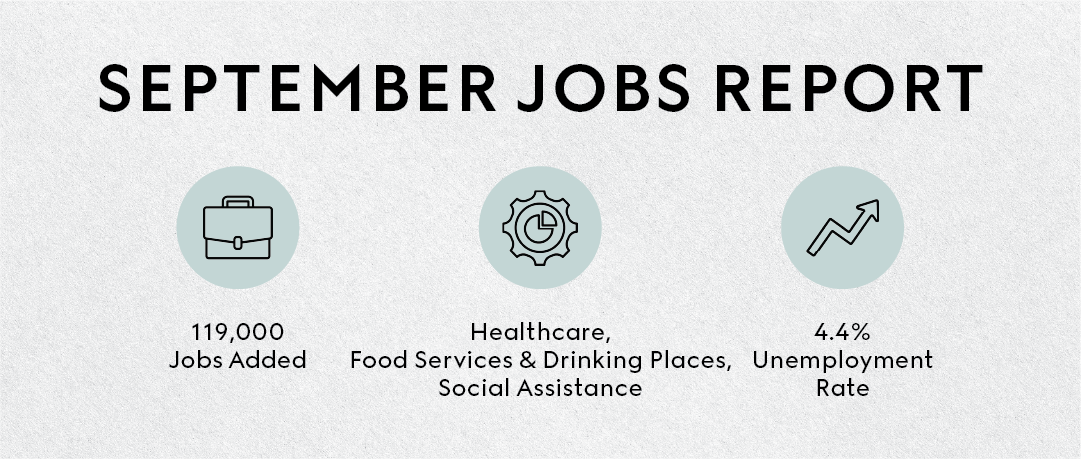September 2025 Jobs Report: The Latest Employment Trends

The latest job report for September provides a comprehensive overview of the current state of employment in the United States.
Federal Government Shutdown Impact
Due to a lapse in federal appropriations, publication of the September report was delayed by over six weeks. While data for the household survey were collected prior to the shutdown, the establishment survey relied on a combination of normal submissions and self-reported electronic data. As a result, the data collection rate was higher than usual (80.2%).
Note: There will be no October 2025 Employment Situation Report. October data will be combined and released with the November report, now scheduled for Tuesday, December 16, 2025, at 8:30 a.m. ET.
September’s Key Findings
The U.S. Bureau of Labor Statistics reported that 119,000 jobs were added in September, marking a modest improvement in job growth. However, total employment has shown little net change since April, reflecting a broader slowdown in hiring momentum. The unemployment rate increased slightly to 4.4%, with the number of unemployed people rising to 7.6 million.
Key sectors include:
- Healthcare
- Food Services & Drinking Places
- Social Assistance
Notable declines:
- Transportation & Warehousing
- Federal Government

Sector-Specific Employment Changes
Employment growth in September 2025 was largely concentrated in service-related industries, while key declines were observed in logistics and public sector roles.
Healthcare
Healthcare continued its strong performance, adding 43,000 jobs, on par with its 12-month average of 42,000 jobs. Growth came primarily from ambulatory health care services (+23,000) and hospitals (+16,000), reflecting sustained demand for direct care and medical services.
Food Services & Drinking Places
This sector added 37,000 jobs in September, extending its consistent recovery as demand for in-person dining and hospitality services grows.
Social Assistance
Social assistance employment rose by 14,000 jobs, driven by a 20,000-job gain in individual and family services. The ongoing need for support programs continues to fuel hiring in this area.
Transportation & Warehousing
Employment in this sector declined by 25,000 jobs in September. Losses were concentrated in warehousing and storage (-11,000) and couriers and messengers (-7,000), suggesting a slowdown in logistics demand.
Federal Government
Federal government jobs declined again, dropping by 3,000 jobs in September. Since peaking in January, the sector has lost 97,000 jobs.
Unemployment Rates
The national unemployment rate rose slightly to 4.4%, up from 4.1% a year ago. The total number of unemployed individuals increased to 7.6 million.
Unemployment rates by demographic group:
- Adult men: 4.0%
- Adult women: 4.2%
- Teenagers: 13.2%
- White population: 3.8%
- Black population: 7.5%
- Asian population: 4.4%
- Hispanic population: 5.5%
The number of long-term unemployed (those out of work for 27 weeks or more) held steady at 1.8 million, accounting for 23.6% of all unemployed individuals.
The labor force participation rate remained unchanged at 62.4%, showing no movement month-over-month or year-over-year. The employment-population ratio was also steady at 59.7%, but has declined by 0.4% points over the year.
Part-time employment for economic reasons stayed flat at 4.6 million. Meanwhile, the number of people not in the labor force but wanting a job fell by 421,000 to 5.9 million, its lowest level in recent months.
Wage Growth & Average Workweek
Wage growth in September continued to trend positively, even amid mixed employment signals:
- Average hourly earnings for all employees on private nonfarm payrolls increased by 0.2% (9 cents) to $36.67.
- Over the past year, hourly earnings have increased by 3.8%.
- Private-sector production and nonsupervisory employees saw their average hourly earnings increase by 0.3% (8 cents) to $31.53.
The average workweek for all employees on private nonfarm payrolls held steady at 34.2 hours. In manufacturing, the average workweek changed little at 39.9 hours, with overtime unchanged at 2.9 hours. For production and nonsupervisory employees, the average workweek edged up by 0.1 hour to 33.7 hours.
Updates To Prior Months’ Employment Data
Revisions to employment figures for July and August revealed a downward adjustment:
- July 2025: Revised down by 7,000 jobs, from +79,000 to +72,000.
- August 2025: Revised down by 26,000 jobs, from +22,000 to -4,000.
Combined, these revisions represent a net downward adjustment of 33,000 jobs, continuing a recent pattern of initial overestimates followed by more conservative corrections.
For further reading, check out our other blogs on topics related to the job market.
Are you looking for top talent? Reach out to us today to get started.
Looking for your next career change? Explore our open jobs today.
Get the latest updates and exclusive content – subscribe to our newsletter!
Partner with Premier today.
Where in striving to do better, we transform lives in shared partnership with our exceptional employer and talent communities.



